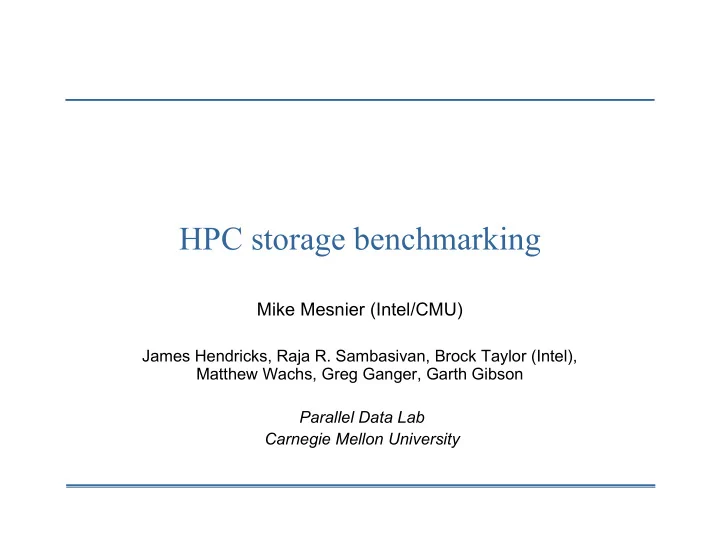

HPC storage benchmarking Mike Mesnier (Intel/CMU) James Hendricks, Raja R. Sambasivan, Brock Taylor (Intel), Matthew Wachs, Greg Ganger, Garth Gibson Parallel Data Lab Carnegie Mellon University
Motivation • HPC apps must be smart about their I/O • Massively parallel access • Collective I/O, strided accesses • May adapt to strengths of the storage system • Consequently, storage system evaluation • Can be difficult for complex applications • Can be expensive (time and money) • HPC storage benchmarking is one solution Generating representative I/O is the challenge 2
Representative I/O?? • Traces • Asynchronous (deterministic) playback • Increasing playback speed is not realistic • Micro-benchmarks • Good for testing specific scenarios (e.g., iozone) • Macro-benchmarks • Useful, but too domain specific (e.g., TPC-C) • Is any one benchmark “representative?” • Computational chemistry, biology, earth sciences , oil/gas, pharmaceuticals, … (probably not) 3
Our approach: “rapid prototyping” 1. Profile the primary I/O phases of an app • Parallelism, write ratio, randomness, etc. 2. Automatically generate I/O processes • A distributed workload generator (e.g., b_eff_io) 3. Generate I/O against system • Good for measuring first-order effects RP is common among distributed systems: • Graphical tools for visualizing/analyzing workflow • Languages for rapid prototyping (e.g, EMSL) • Compilers to generate synthetic processes 4
Example icons for rapid prototyping WRITE READ EXE • Read, execute or write process • Input or output DISK Speed • Allows for parallelism between two processes Matching buffer I/O • Producer/consumer buffer (no parallelism) Bucket PIPE • IPC between two nodes 5
Example (computational chemistry) • For all nodes do • Read in basis sets (atomic orbitals) • Compute atomic integrals • Write atomic integrals to disk WRT Basis EXE Basis RD Integrals Integrals sets sets Must specify characteristics of each process (e.g., request size, access pattern, passes over data) 6
Next steps • Select a modeling environment • Graphical tools, language, compiler • E.g., FileBench from Wednesday’s BOF • Extend modeling environment for HPC • Multiple processes, parallel I/O, barriers and synchronization, strided access, … • Provide “reference” profiles for common apps • Computational chemistry, oil/gas, etc. Questions? 7
Recommend
More recommend